LINES INTERVALS AND RAYS
Subscribe to our ▶️ YouTube channel 🔴 for the latest videos, updates, and tips.
Line
What is a line ?
Line is a geometrical object that is straight, endless and thin. It is continuous and we can increase the length, straight or curved. It will not have thickness; the trace of proceeding points.
As the space in between the points decreases they join to form a line. A line is a set of points closely arranged without gap.
Mark A, B on a sheet of paper using a scale and draw a line passing through these points.
This is a straight line.
It is represented as straight line AB or line l.
When we represent a straight line as AB, it means,
(i) The line passes through the points A and B.
(ii) The line extends on either side of A and B.
Observe the names given for the following straight lines.


Ray
A ray starts from a fixed point and extends indefinitely in other direction.

1. Starting point of the ray is A.
2. The ray passes through the points A and B.
3. The ray extends through the point B.
A ray is a straight line with a starting point and extends indefinitely in one direction.
Line Segment
If a sheet of paper is folded and then opened, the folded part represents the line segment.
It is shown in the figure given below.
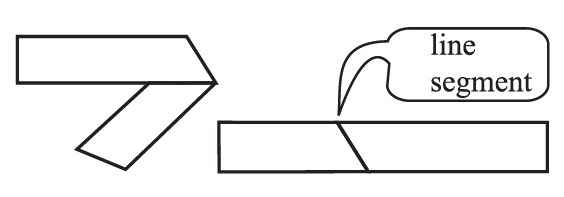
Mark X, Y and Z on the straight line AB.

Consider AX a part of the straight line, which starts at A and ends at X. So, it has a particular length. This is called a line segment. It can be denoted as line segment AX.
Few more line segments from the above figure are AY, AB, XY, XB, YB, XZ.
Therefore line segment is a part of a line. It has a starting point and end point.
A line segment has definite length.
Intervals
An interval is a connected portion of the real line. If the endpoints and are finite and are included, the interval is called closed and is denoted [a, b].

If the endpoints are not included, the interval is called open and denoted (a, b).

If one endpoint is included but not the other, the interval is denoted or and is called a half closed interval (or half-open interval).
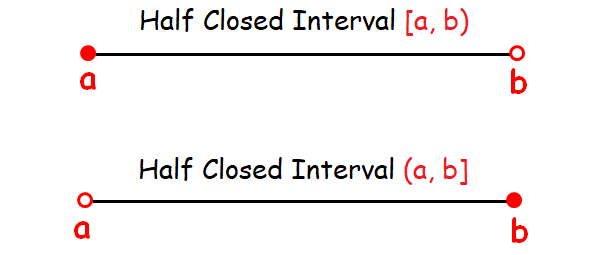
Problem 1 :
1) _____ The point at which two lines intersect
2) ________ A set of points in a straight path that extends infinitely in both directions.
3) __________ Two lines that from a right angle at their point of intersection.
4) ______ Position in space, often represented by a dot.
5) ______ a finite portion of a line that has two endpoints.
6) _____ Three or more points that lie in the same line.
7) _______ A point that bisects a line segment
8) ______ lines in the same plane that will never intersect.
Solution :
1) The point of intersection.
2) line
3) Perpendicular lines
4) a point
5) Line segment
6) Collinear points
7) Midpoint
8) Parallel lines
Problem 2 :
Name the segments and rays in the figure at the below.
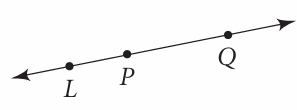
Solution :
LP, LQ, PQ and QP are the rays.
Problem 3 :
Name all segments shown in the diagram that are parallel to the given segment.
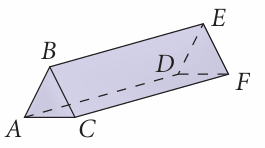
a) AC b) EF c) AD
Name all segments shown in the diagram that are skew to the given segment.
d) AC e) EF f) AD
Solution :
a) Parallel for the line segment AC is DF
b) Parallel for the line segment EF is BC
c) Parallel for the line segment AD is CF.
Skew lines will not intersect or parallel to each other
d) For AC, DF is the parallel line, CF and AD are intersecting lines. Excepting these,
DF, EF and BE are skew lines
e) For EF, BC is the parallel line, BE and CF are intersecting lines. Excepting these,
AB, DF and AD are skew lines
f) For AD, CF is the parallel lines. AB, AC, BE and BF are intersecting lines. BC and EF are skew lines.
Problem 4 :
Judging by appearances, will the lines intersect?
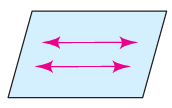
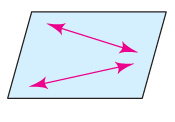
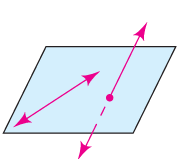
Solution :
 |
These lines are parallel, so they will never intersect. |
 |
These lines are not travelling the in same path, they may not parallel and they must be intersecting. |
 |
They are not parallel and they are not intersecting. Then they are skew lines. |
Problem 5 :
Describe the statement as true or false. If false explain.
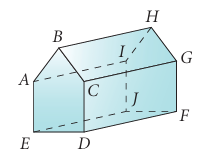
a) CB || HG
b) ED || HG
c) Plane AED || plane FGH
d) Plane ABH || plane CDF
e) AB and HG are skew lines.
f) CG and AI are skew lines.
g) AE and BC are skew lines.
h) CF and AJ are skew lines.
Solution :
a) CB || HG
The lines CB and HG are parallel lines. So, it is true.
b) ED || HG
ED and HG are not travelling in the same path. So, they are not parallel. It is false.
c) Plane AED || plane FGH
It is true.
d) Plane ABH || plane CDF
It is false, because they intersect above CG.
e) AB and HG are skew lines.
It is true. Because they are not parallel or intersecting.
f) CG and AI are skew lines.
It is false, because they are parallel.
g) AE and BC are skew lines.
Ture.
h) CF and AJ are skew lines.
It is false, because they are parallel.
Subscribe to our ▶️ YouTube channel 🔴 for the latest videos, updates, and tips.
Kindly mail your feedback to v4formath@gmail.com
We always appreciate your feedback.
©All rights reserved. onlinemath4all.com
Recent Articles
-
SAT Math Practice
Dec 05, 25 04:04 AM
SAT Math Practice - Different Topics - Concept - Formulas - Example problems with step by step explanation -
10 Hard SAT Math Questions (Part - 37)
Dec 03, 25 07:02 AM
10 Hard SAT Math Questions (Part - 37) -
Factorial Problems and Solutions
Dec 02, 25 09:27 AM
Factorial Problems and Solutions

